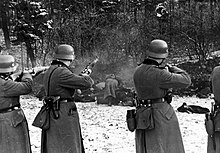Bochnia
| Bochnia | ||
|---|---|---|

|
|
|
| Basic data | ||
| State : | Poland | |
| Voivodeship : | Lesser Poland | |
| Powiat : | Bochnia | |
| Area : | 29.89 km² | |
| Geographic location : | 49 ° 59 ′ N , 20 ° 26 ′ E | |
| Residents : | 29,814 (Jun. 30, 2019) |
|
| Postal code : | 32-700 and 32-701 | |
| Telephone code : | (+48) 14 | |
| License plate : | KBC | |
| Economy and Transport | ||
| Street : | E 40 Wroclaw - Tarnów | |
| Rail route : | Wroclaw - Medyka | |
| Next international airport : | Krakow-Balice | |
| Gmina | ||
| Gminatype: | Borough | |
| Residents: | 29,814 (Jun. 30, 2019) |
|
| Community number ( GUS ): | 1201011 | |
| Administration (as of 2015) | ||
| Mayor : | Stefan Kolawinski | |
| Address: | ul. Kazimierza Wielkiego 2 32-700 Bochnia |
|
| Website : | www.bochnia.eu | |
Bochnia [ 'bɔxɲa ] ( German salt mountain ) is a city in Poland in the Lesser Poland Voivodeship , about 40 km east of Krakow , on the Raba River . The Bochnia Salt Mine was added to the UNESCO list of World Heritage Sites in 2013.
history
The first signs of a settlement called Bochegna , where salt was mined, come from the year 1198. Around 1248, the intensified mining of salt was responsible for the upswing of the place. On February 27, 1253, he received city rights under Magdeburg law from Boleslaw the Shameful . In the founding privilege , the city was named bilingually: qui Polonice Bochnija et Saltzberk Theutonice nuncupatur , but the German name was rarely used afterwards.
In the centuries that followed, mining developed above all, but also craft, especially cloth production. In 1537 Szymon Zacjusz settled in Bochnia, who became a supporter of the Augsburg and later the Helvetic denominations. The Reformation included in the second half of the 16th century by 60 families, or 10% of urban residents.
From 1655 to 1657 the place was badly destroyed by the Swedes. In July 1772 Bochnia came to Austria as part of the first partition of Poland-Lithuania . In the course of the Josephine colonization , two colonies of German salt mine workers emerged: Trinitatis in Chodenice , northwest of the city, and Vogtsdorf or Wójtostwo in Podedworze - southeast of Bochnia. In 1856 the place was connected to the rail network between Dębica - Krakow - Vienna by the Kaiser-Ferdinand-Nordbahn . In 1909 a sewer system was laid for the houses in the city. Bochnia's first public library opened in 1886, and the first permanent cinema in 1913.
During the First World War , the site was the scene of fighting between Russia and Austria.
During the German campaign in Poland on December 16, 1939, members of the Polish underground organization “White Eagle” (Polish: Orzeł Biały ) attacked the German police station and killed two German police officers, including the commanding officer. Two seriously wounded Poles were hung from lamp posts the next day. Another 52 people were shot by German Wehrmacht soldiers. It was one of the earliest mass executions by Germans on Polish soil. As a result, many residents of Bochnia were deported to concentration camps or to Germany for forced labor; the Bochnia ghetto served as a collection camp for this purpose. Despite everything, there were numerous resistance groups in the vicinity of the city. Bochnia was also called Salzberg during the occupation .
City structure
There are 14 districts (see osiedle ):
- Osiedle nr 1 Śródmieście-Campi
- Osiedle nr 2 Słoneczne
- Osiedle nr 3 Krzęczków-Łychów
- Osiedle nr 4 Uzbornia
- Osiedle nr 5 Niepodległości
- Osiedle nr 6 Windakiewicza
- Osiedle nr 7 Kolanów
- Osiedle nr 8 Dołuszyce
- Osiedle nr 9 Chodenice
- Osiedle nr 10 Kurów
- Osiedle nr 11 sw. Jana Murowianka
- Osiedle nr 12 Smyków
- Osiedle nr 13 Karolina-Krzeczowska
- Osiedle nr 14 Proszowskie
Kolanów (7), Chodenice (9), Dołuszyce (8) and Kurów (10) were incorporated into the municipality in 1973.
Rural municipality Bochnia
The rural municipality of Bochnia, to which the city of Bochnia itself does not belong, has an area of 131 km², on which 19,955 people live (June 30, 2019).
Personalities
- Helena Modrzejewska (1840–1909), Polish actress
- Wiktor Barabasz (1855–1925), Polish pianist, conductor and music teacher
- Ralph Modrzejewski (1861–1940), Polish-American bridge construction engineer
- Roger Battaglia (1873–1950), Austrian-Polish lawyer, economist and member of the Austrian House of Representatives
- Salo Landau (1903–1944), Dutch chess master of Galician descent, murdered in the Gräditz forced labor camp (Grodziszcze)
- Jerzy Katlewicz (1927–2015), Polish conductor and music teacher
- Gabriel Laub (1928–1998), journalist, satirist and aphorist of Polish-Jewish origin
Twin cities
- Bad Salzdetfurth (Germany)
- Cavtat (Croatia)
- Kežmarok (Slovakia)
- Roselle (USA)
- District of Saarlouis (Germany)
Web links
- official website of the city (Polish)
- another page about the city (polish)
Individual evidence
- ↑ a b population. Size and Structure by Territorial Division. As of June 30, 2019. Główny Urząd Statystyczny (GUS) (PDF files; 0.99 MiB), accessed December 24, 2019 .
- ^ Walter Schlesinger: Lectures and Research . J. Thorbecke, 1975, ISBN 978-3-7995-6618-6 ( google.de [accessed March 6, 2019]).
- ↑ Tomasz Jurek (editor): BOCHNIA ( pl ) In: Słownik Historyczno-Geograficzny Ziem Polskich w Średniowieczu. Edycja elektroniczna . PAN . 2010-2016. Retrieved April 22, 2019.
- ↑ Reformacja w Bochni i okolicach
- ↑ deathcamps.org: Ghetto Bochnia
- ↑ Publication Office Berlin-Dahlem: The Eastern Territories of the German Reich and the General Government of the Occupied Polish Territories in statistical information . Self-published, 1940 ( google.de [accessed on March 4, 2019]).
- ↑ Załącznik No. 8 do Statutu Gminy Miasta Bochnia.



